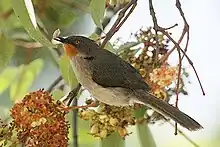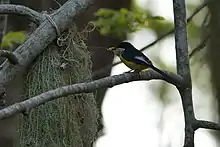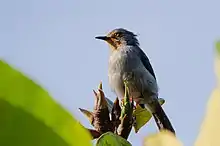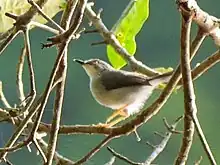| Apalises | |
|---|---|
 | |
| Chestnut-throated apalis (Apalis porphyrolaema) | |
| Scientific classification | |
| Domain: | Eukaryota |
| Kingdom: | Animalia |
| Phylum: | Chordata |
| Class: | Aves |
| Order: | Passeriformes |
| Family: | Cisticolidae |
| Genus: | Apalis Swainson, 1833 |
| Type species | |
| Motacilla thoracica[1] Shaw, 1811 | |
| Species | |
|
See species list | |
The apalises are small passerine birds belonging to the genus Apalis, in the family Cisticolidae. They are found in forest, woodlands and scrub across most parts of sub-Saharan Africa.[2] They are slender birds with long tails and have a slender bill for catching insects. They are typically brown, grey or green above and several species have brightly coloured underparts. Males and females are usually similar in appearance but the males are sometimes brighter.[2]
The genus was erected by the English naturalist William John Swainson in 1833. The type species is the bar-throated apalis.[3][4] The name Apalis is from the Ancient Greek hapalos meaning "delicate" or "gentle".[5] Apalises were traditionally classified in the Old World warbler family Sylviidae but are now commonly placed, together with several other groups of mainly African warblers, in a separate family Cisticolidae.[6]
There are about 24 species of apalis; the exact number varies according to differing authorities. The African tailorbird and long-billed tailorbird were formerly considered to be apalises but are now often placed either with the tailorbirds (Orthotomus) or in their own genus Artisornis.[2] The red-fronted prinia or red-faced apalis has also been moved into a different genus, Prinia.[7] Further shuffling may be necessary as a recent study[8] found the genus to be polyphyletic, with two species (black-collared and Ruwenzori apalises) only distantly related to the other three tested.
Species list
The genus contains 25 species:[9]
| Image | Common Name | Scientific Name | Distribution |
|---|---|---|---|
.jpg.webp) | Bar-throated apalis | Apalis thoracica | Tropical Africa |
| Yellow-throated apalis | Apalis flavigularis | Malawi. | |
| Taita apalis | Apalis fuscigularis | Kenya. | |
| Namuli apalis | Apalis lynesi | Mozambique | |
.jpg.webp) | Rudd's apalis | Apalis ruddi | Mozambique, southern Malawi, South Africa and Eswatini. |
| Brown-tailed apalis | Apalis flavocincta[10] | Ethiopia, Sudan, and Uganda to Somalia and Kenya. | |
 | Yellow-breasted apalis | Apalis flavida | Angola, Benin, Botswana, Burkina Faso, Burundi, Cameroon, Central African Republic, Chad, Republic of the Congo, DRC, Ivory Coast, Eswatini, Ethiopia, Gabon, Gambia, Ghana, Guinea, Guinea-Bissau, Kenya, Malawi, Mali, Mozambique, Namibia, Nigeria, Rwanda, Sierra Leone, Somalia, South Africa, South Sudan, Tanzania, Togo, Uganda, Zambia, and Zimbabwe. |
 | Lowland masked apalis | Apalis binotata | Angola, Cameroon, Democratic Republic of the Congo, Equatorial Guinea, Gabon, Tanzania, and Uganda. |
_(18265650889).jpg.webp) | Mountain masked apalis | Apalis personata | Uganda |
.jpg.webp) | Black-throated apalis | Apalis jacksoni | Cameroon to Kenya, |
 | White-winged apalis | Apalis chariessa | Kenya, Malawi, Mozambique, and Tanzania. |
.jpg.webp) | Black-capped apalis | Apalis nigriceps | Sub-Saharan Africa. |
.jpg.webp) | Black-headed apalis | Apalis melanocephala | Kenya, Malawi, Mozambique, Somalia, Tanzania, and Zimbabwe. |
 | Chirinda apalis | Apalis chirindensis | Zimbabwe and Mozambique. |
.jpg.webp) | Chestnut-throated apalis | Apalis porphyrolaema | Burundi, Democratic Republic of the Congo, Kenya, Rwanda, Tanzania and Uganda |
| Kabobo apalis | Apalis kaboboensis | Democratic Republic of the Congo | |
| Chapin's apalis or chestnut-headed apalis | Apalis chapini | Malawi, Tanzania, and Zambia. | |
.jpg.webp) | Sharpe's apalis | Apalis sharpii | Côte d'Ivoire, Ghana, Guinea, Liberia, and Sierra Leone. |
 | Buff-throated apalis | Apalis rufogularis | Angola, Benin, Burundi, Cameroon, Central African Republic, Republic of the Congo, Democratic Republic of the Congo, Equatorial Guinea, Gabon, Kenya, Nigeria, Rwanda, South Sudan, Tanzania, Uganda, and Zambia. |
| Kungwe apalis | Apalis argentea | Burundi, Democratic Republic of the Congo, Rwanda, and Tanzania. | |
 | Karamoja apalis | Apalis karamojae[11] | Tanzania, Uganda and Kenya. |
 | Bamenda apalis | Apalis bamendae | Cameroon. |
 | Gosling's apalis | Apalis goslingi | Angola, Cameroon, Central African Republic, Republic of the Congo, Democratic Republic of the Congo, and Gabon. |
_(cropped).jpg.webp) | Grey apalis | Apalis cinerea | Angola, Burundi, Cameroon, Democratic Republic of the Congo, Equatorial Guinea, Gabon, Kenya, Nigeria, Rwanda, South Sudan, Sudan, Tanzania, and Uganda. |
| Brown-headed apalis | Apalis alticola | Angola, Zambia, Malawi, south-eastern Democratic Republic of Congo, Tanzania and Kenya | |
Formerly in Apalis but now moved to Oreolais:[12]
- Black-collared apalis, Oreolais pulchra
- Rwenzori apalis or collared apalis, Oreolais ruwenzorii
References
- ↑ "Cisticolidae". aviansystematics.org. The Trust for Avian Systematics. Retrieved 2023-07-15.
- 1 2 3 Sinclair, Ian; Ryan, Peter (2003). Birds of Africa south of the Sahara. Struik. pp. 512, 540. ISBN 1-86872-857-9.
- ↑ Swainson, William John (1833). Zoological Illustrations, or original figures and descriptions of new, rare, or interesting Animals, selected chiefly from the classes of ornithology, entomology, and conchology and arranged according to their apparent affinities. Series 2. Vol. 3. London: Baldwin and Cradock. Plate 119 text.
- ↑ Mayr, Ernst; Cottrell, G. William, eds. (1986). Check-list of Birds of the World. Vol. 11. Cambridge, Massachusetts: Museum of Comparative Zoology. p. 154.
- ↑ Jobling, James A. (2010). The Helm Dictionary of Scientific Bird Names. London: Christopher Helm. p. 50. ISBN 978-1-4081-2501-4.
- ↑ Roberson, Don. "Cisticolas & Allies Cisticolidae". Archived from the original on 21 April 2007. Retrieved 2007-03-29.
- ↑ Lepage, Denis. "Red-faced Apalis (Urorhipis rufifrons) (Rüppell, 1840)". Archived from the original on 2007-09-29. Retrieved 2007-03-29.
- ↑ Nguembock, B; Fjeldså, J.; Tillier, A.; Pasquet, E. (2007). "A phylogeny for the Cisticolidae (Aves: Passeriformes) based on nuclear and mitochondrial DNA sequence data, and a re-interpretation of an [sic] unique nest-building specialization". Molecular Phylogenetics and Evolution. 42 (1): 272–286. doi:10.1016/j.ympev.2006.07.008. PMID 16949311.
- ↑ Olsson, U.; Irestedt, M.; Sangster, G.; Ericson, P.G.P.; Alström, P. (2013). "Systematic revision of the avian family Cisticolidae based on a multi-locus phylogeny of all genera". Molecular Phylogenetics and Evolution. 66 (3): 790–799. doi:10.1016/j.ympev.2012.11.004. PMID 23159891.
- ↑ "Species Updates – IOC World Bird List". Retrieved 2021-06-18.
- ↑ Shaw, Philip; Mungaya, Elias (2006). "The status and habitat of Karamoja Apalis Apalis karamojae in the Wembere Steppe, Sukumaland, Tanzania". Bird Conservation International. 16 (2): 97–111. doi:10.1017/S0959270906000049.
- ↑ Nguembock, B.; Fjeldså, J.; Couloux, A.; Cruaud, C.; Pasquet, E. (2008). "Polyphyly of the genus Apalis and a new generic name for the species pulchra and ruwenzorii". Ibis. 150 (4): 756–765. doi:10.1111/j.1474-919X.2008.00852.x.
Further reading
- Ryan, Peter (2006). "Family Cisticolidae (Cisticolas and allies)". In del Hoyo J., Elliott A.; Christie D.A. (eds.). Handbook of the Birds of the World. Vol. 11. Old World Flycatchers to Old World Warblers. Barcelona: Lynx Edicions. pp. 378–492. ISBN 978-84-96553-06-4.